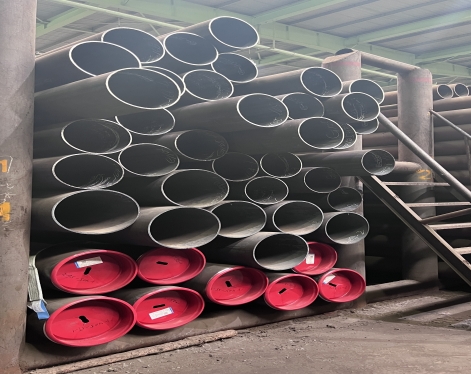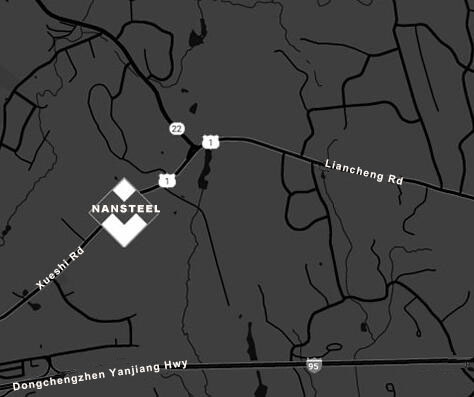High-pressure boiler tubes are a type of boiler tube, belonging to the category of seamless steel pipes. The manufacturing method is the same as for seamless pipes, but there are strict requirements on the steel grades used. High-pressure boiler tubes are frequently used under high temperature and pressure conditions, and the tubes will undergo oxidation and corrosion under the influence of high-temperature flue gas and steam. Therefore, the steel pipes are required to have high creep strength, high resistance to oxidation and corrosion, and good structural stability. High-pressure boiler tubes are mainly used to manufacture superheater tubes, reheater tubes, steam pipes, and main steam pipes for high-pressure and ultra-high-pressure boilers.
Materials Materials: 20G, 20MnG, 25MnG, 15MoG, 20MoG, 12CrMoG, 15CrMoG, 12Cr2MoG, 12CrMoVG, 12Cr3MoVSiTiB, 1Cr18Ni9, 1Cr18Ni11Nb
Applications of High-Pressure Boiler Steel Tubes: High-pressure boiler steel tubes are mainly used to manufacture seamless carbon structural steel, alloy structural steel, and stainless heat-resistant steel tubes for steam boilers operating at high pressures and above. These boiler tubes frequently operate under high temperatures and pressures, and the tubes are exposed to high-temperature flue gas and steam. Oxidation and corrosion can occur during use, therefore, the steel pipes are required to have high creep strength, high oxidation resistance, and good structural stability.
They are used for heating surface tubes in low and medium pressure boilers (working pressure generally not exceeding 5.88 MPa, working temperature below 450℃); and for heating surface tubes, economizers, superheaters, reheaters, and petrochemical industry tubes in high pressure boilers (working pressure generally above 9.8 MPa, working temperature between 450℃ and 650℃).
In addition to ensuring chemical composition and mechanical properties, high-pressure boiler tubes must undergo individual hydrostatic testing, flaring, and flattening tests. The steel pipes are delivered in a heat-treated state. Furthermore, there are certain requirements for the microstructure, grain size, and decarburized layer of the finished steel pipes.
What are the main steel grades used for high-pressure boiler tubes?
The steel grades used include: high-quality carbon structural steel grades 20G, 20MnG, and 25MnG; alloy structural steel grades 15MoG, 20MoG, 12CrMoG, 15CrMoG, 12Cr2MoG, 12CrMoVG, and 12Cr3MoVSiTiB; and commonly used rust-resistant heat-resistant steels such as 1Cr18Ni9 and 1Cr18Ni11Nb. In addition to ensuring chemical composition and mechanical properties, each high-pressure boiler tube must undergo a hydrostatic test, as well as flaring and flattening tests. The steel pipes are delivered in a heat-treated state. Furthermore, there are specific requirements for the microstructure, grain size, and decarburization layer of the finished steel pipes.Specifications, materials, and standards for high-pressure boiler tubes:
Specifications: Outer diameter 10-630 mm, wall thickness 2.0-80 mmMaterials Materials: 20G, 20MnG, 25MnG, 15MoG, 20MoG, 12CrMoG, 15CrMoG, 12Cr2MoG, 12CrMoVG, 12Cr3MoVSiTiB, 1Cr18Ni9, 1Cr18Ni11Nb
| Size | Schedule | Wall | ID |
| 1/8" | 10S | 0.49 | 0.307 |
| .405" OD | 40ST, 40S | 0.68 | 0.269 |
| 80SX, 80S | 0.095 | 0.215 | |
| 1/4" | 10S | 0.065 | 0.41 |
| .540" OD | 40ST, 40S | 0.088 | 0.364 |
| 80SX, 80S | 0.119 | 0.302 | |
| 3/8" | 10S | 0.065 | 0.545 |
| .675" | 40ST, 40S | 0.091 | 0.493 |
| 80SX, 80S | 0.126 | 0.423 | |
| 1/2" | 5S | 0.065 | 0.71 |
| .840" | 10S | 0.0835 | 0.674 |
| 40ST, 40S | 0.109 | 0.622 | |
| 80SX, 80S | 0.147 | 0.546 | |
| 160 | 0.188 | 0.464 | |
| XX | 0.294 | 0.252 | |
| 3/4" | 5S | .065" | 920" |
| 10S | .083" | .884" | |
| 1.050 OD" | 40ST, 40S | .113" | .824" |
| 80SX, 80S | .154" | .742" | |
| 160 | .219" | .612" | |
| XX | .308" | .434" |
| Steel Grade | Standard | Application | ||
| GB(China) | ASME(USA) | DIN/EN(Euro) | ||
| Carbon steel | 10 | SA-106B | PH265GH | Economizer tube |
| 20 | SA-192 | P195GH | Water wall tube | |
| 20G | SA-210A1 | P235GH | ||
| 20MnG | SA106C | St35.8 | ||
| 25MnG | SA-210C | St45.8 | ||
| Mo steel | 15MoG | SA-209 T1 | 15Mo3 | Water wall tube |
| 20MoG | SA-209 T1a | 16Mo3 | Superheater tube | |
| SA-209 T1b | Reheater tube | |||
| Cr-Mo Steel | 12CrMoG | SA-213 T11 SA-213 T22 | 12Cr1MoV | Superheater tube |
| 12Cr2MoG | SA-213 T24 SA-213 T91 | 14MoV63 | Reheater tube | |
| 12Cr1MoVG | A335 P1 A335 P2 | 10CrMo910 | ||
| 15CrMoG | A335 P5 A335P9 | X10CrMoVNb91 | ||
| 10Cr9MoVNb | A335 P11 | 10CrMo5-5, 13CrMo4-5 | ||
| Cr-Mo-W steel | 12Cr2MoWVTiB | SA-213 T23 SA-214 T911 | --- | Superheater tube |
| SA-213 T92 SA-213 T122 | Reheater tube | |||
| A335 P23 A335 P911 | ||||
| A335 P92 A335 P122 | ||||
| Austentic Stainless steel | --- | AP304 TP304H | --- | Superheater tube |
| TP321 TP321H | Reheater tube | |||
| TP347 TP347H | ||||
| TP316 TP316H | ||||
| S30432 TP310HCbN | ||||
Applications of High-Pressure Boiler Steel Tubes: High-pressure boiler steel tubes are mainly used to manufacture seamless carbon structural steel, alloy structural steel, and stainless heat-resistant steel tubes for steam boilers operating at high pressures and above. These boiler tubes frequently operate under high temperatures and pressures, and the tubes are exposed to high-temperature flue gas and steam. Oxidation and corrosion can occur during use, therefore, the steel pipes are required to have high creep strength, high oxidation resistance, and good structural stability.
They are used for heating surface tubes in low and medium pressure boilers (working pressure generally not exceeding 5.88 MPa, working temperature below 450℃); and for heating surface tubes, economizers, superheaters, reheaters, and petrochemical industry tubes in high pressure boilers (working pressure generally above 9.8 MPa, working temperature between 450℃ and 650℃).
In addition to ensuring chemical composition and mechanical properties, high-pressure boiler tubes must undergo individual hydrostatic testing, flaring, and flattening tests. The steel pipes are delivered in a heat-treated state. Furthermore, there are certain requirements for the microstructure, grain size, and decarburized layer of the finished steel pipes.









